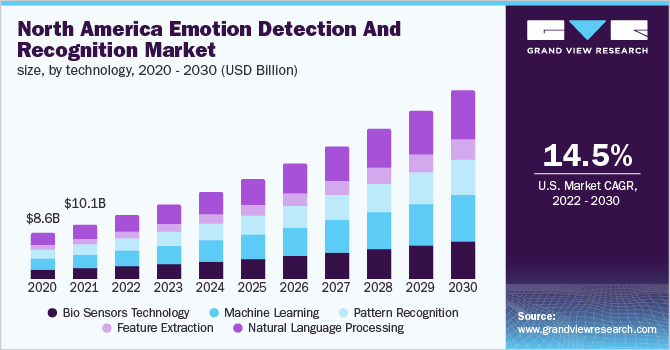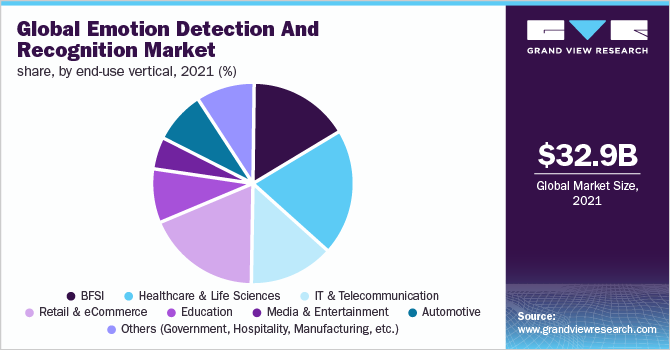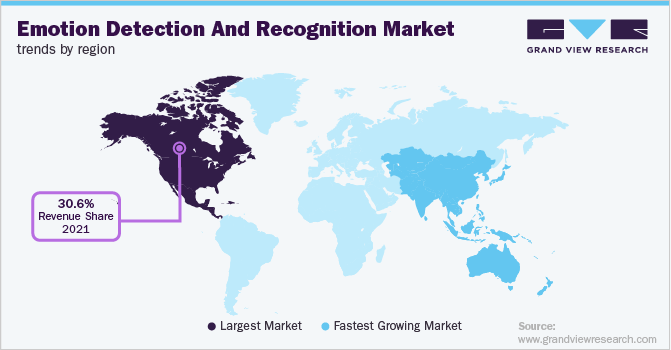- Home
- »
- Next Generation Technologies
- »
-
Emotion Detection And Recognition Market Size Report, 2030GVR Report cover
![Emotion Detection And Recognition Market Size, Share, & Trends Report]()
Emotion Detection And Recognition Market Size, Share, & Trends Analysis Report By Component, By Tools, By Technology, By Application, By End Use Vertical, By Region, And Segment Forecasts, 2022 - 2030
- Report ID: GVR-4-68039-960-8
- Number of Pages: 100
- Format: Electronic (PDF)
- Historical Range: 2017 - 2020
- Industry: Technology
Report Overview
The global emotion detection and recognition market size was valued at USD 32.95 billion in 2021 and is expected to expand at a compound annual growth rate (CAGR) of 16.7% from 2022 to 2030. Emotion detection and recognition have gained significant prominence in recent years owing to prominent advancements in Machine Learning (ML) and Artificial Intelligence (AI). The increasing adoption of biometrics is the prominent factor driving the growth of the industry. The growing use of voice-driven and gesture-driven navigation systems and workstations is impelling growth in the software and hardware segments.

Furthermore, significant expansion in IoT-based technologies increased the adoption of wearable technologies, and a massive increase in smartphone usage is also fostering the growth of the industry. Emotion detection and recognition is a software-based technique that enables an organization with human emotion detection using computer vision, deep learning algorithms, and AI to read facial expressions. Aside from happiness, rage, and sorrow, emotion detection and identification software would also look at micro-expressions like disdain and contempt.
During the engagement process between people and machine communication systems, understanding emotions are critical. Emotion recognition software not only improves human-computer interfaces but also improves the actions made by computers in response to user feedback. The rising demand for speech-based emotion detection systems to analyze emotional states, global adoption of AI, IoT, deep learning, and machine learning technologies, increasing need in the field of automotive artificial intelligence, increasing requirement for socially intelligent artificial agents, and high operational excellence are among the major factors driving the market growth.
Component Insights
In terms of revenue, the software segment held the largest revenue share of over 66% in 2021. This dominant share of the segment is attributable to the increasing consumer preference for the in-house installation of the systems. Based on components, the market is segmented into software and services. IoT-based technologies also facilitate monitoring and responding to all devices following the actions and emotions of a person.
The devices transmit data without human intervention, such as sensor input that controls the output of a remote industrial process. Emotion-sensing technology is progressing to reality from an experimental phase. For example, Apple Inc.'s virtual assistant 'Siri' is designed to create how emotions are presented on the mood-tracking app named Moodnotes. Subsequently, it would help to boost the application of emotion recognition.
Tools Insights
In terms of revenue, the speech & voice recognition segment accounted for the highest share of 43.8% in 2021. Likewise, facial expression and recognition provide fast and accurate results, reliable matching, a non-contact process, and various applications such as border control, crime-fighting, law enforcement agencies, and access control.
Furthermore, some primary advantages of facial expression recognition systems are reduced fraud, improved security, an automated facial system, simple integration, and a high success rate. The government and defense sectors are significantly investing in facial recognition technology, and technological advancements are becoming more prevalent across all industry verticals. These are the main drivers propelling the growth of the facial recognition market.
Technology Insights
The Natural Language Processing (NLP) segment held the largest revenue share of 26.4% in 2021. Advanced technologies such as natural language processing, computational linguistics, and affective computing also foster R&D activities in emotion detection & recognition technologies. Based on technology, the market was segmented into feature extraction, pattern recognition, biosensors technology, natural language processing, and machine learning.
The AI-based technology industry is also likely to grow as the system effectively analyses emotional patterns. Artificial intelligence translates patterns into well-structured algorithms by performing steps such as representing pattern units, formulating and developing recognition algorithms, and demonstrating accurate inputs. The AI-based emotion detection and recognition industry is predicted to rise due to advancements in machine learning and natural language processing.
Application Insights
The surveillance and monitoring segment held the largest share of over 27% in 2021 in terms of revenue. Based on applications emotion detection and recognition market is segmented into surveillance and monitoring, marketing and advertising, robotics and E-learning, medical emergency, and others.
The marketing and advertising segment is estimated to witness a prominent growth rate during the forecast period. Recognizing how customers feel has become a critical corporate goal. When making major choices, businesses must keep the perspective of their customers in mind. Exploring the consumer perspective requires using emotion detection and identification technologies in corporate marketing and advertising.
End-use Vertical Insights
In terms of revenue, the healthcare & life sciences segment accounted for the highest share of 20.7% in 2021. Based on end-use vertical, the market has been further divided into the BFSI, healthcare & life sciences, IT & telecommunication, retail and e-commerce, education, media and entertainment, automotive, and others. Speech recognition enhances the process of capturing data in Electronic Health Record (EHR) systems. This process enables the interaction of doctors with the system by speaking a few words.

Emotion recognition software is used by industrial end-users to decrease or prevent fraudulent actions. This technology may be integrated into products and utilized in various sectors, such as the automobile industry, to provide an emotional connection with consumers and collect data with emotion sensors to understand human emotions better and improve customer experiences.
Regional Insights
In terms of revenue, North America held the largest revenue share of 30.6% in 2021. The rapid growth of the Internet of Things (IoT), and the growing popularity of wearable devices with enhanced technology provide enormous opportunities for the regional market. The expansion is also aided by the increased government spending and the growing need for better services and security from various business verticals.

In the Asia Pacific region, developing countries like India and China are projected to witness increased demand for expanded technology rollout and strategies to develop uniform and effective emotion detection and recognition systems. Furthermore, the growing population, strong technical centers, and the existence of a large number of companies in the region are also providing impetus for regional growth.
Key Companies & Market Share Insights
The market witnesses significant competitive intensity owing to the prevalence of a large number of participants. The vendors are focused on expanding their consumer base to gain a competitive edge. Subsequently, leading market participants are taking various strategic initiatives, such as partnerships and mergers & acquisitions. Strategic initiatives taken by prominent companies in the market have positively impacted market growth.
For instance, in April 2019, Affectiva closed a USD 26 million investment round to expand its emotion and object detection artificial intelligence for car passenger monitoring. Aptiv, an automotive supplier, lead the investment round. Affectiva wants its technology to be integrated into automobile safety cameras to detect if a driver is happy, frustrated, sad, or, drowsy. Some prominent players in the global emotion detection and recognition market include:
-
Affectiva
-
Apple Inc.
-
Emotient Inc.
-
Eyeris
-
Kairos AR Inc.
-
Noldus Information Technology
-
Realeyes
-
Sentiance
-
Sightcorp
-
SkyBiometry
-
NVISO
-
Q3 technologies Inc.
-
Paravision Inc.
-
NEC Corporation
-
Tobii
-
Cognitec
Emotion Detection And Recognition Market Report Scope
Report Attribute
Details
Market size value in 2022
USD 39.63 billion
Revenue forecast in 2030
USD 136.46 billion
Growth rate
CAGR of 16.7% from 2022 to 2030
Base year for estimation
2021
Historical data
2017 - 2020
Forecast period
2022 - 2030
Quantitative units
Revenue in USD million/billion and CAGR from 2022 to 2030
Report coverage
Revenue forecast, competitive landscape, growth factors, and trends
Segments Covered
Component, tool, technology, application, end-use vertical, region
Regional scope
North America; Europe; Asia Pacific; South America; MEA
Country scope
U.S.; Canada; Mexico; U.K.; Germany; France; China; India; Japan; Brazil
Key companies profiled
Affectiva; Apple Inc; Emotient Inc; Eyeris; Kairos AR Inc; Noldus Information Technology; Realeyes; Sentiance; Sightcorp; SkyBiometry; NVISO; Q3 technologies Inc; Paravision Inc; NEC Corporation; Tobii; Cognitec
Customization scope
Free report customization (equivalent to up to 8 analyst working days) with purchase. Addition or alteration to country, regional, and segment scope.
Pricing and purchase options
Avail of customized purchase options to meet your exact research needs. Explore purchase options
Global Emotion Detection And Recognition Market Segmentation
This report forecasts revenue growth at the global, regional, and country levels and provides an analysis of the latest industry trends in each of the sub-segments from 2017 to 2030. For this study, Grand View Research has segmented the global voice and speech recognition market report based on component, tools, technology, application, end-use vertical, and region:
-
Component Outlook (Revenue, USD Million, 2017 - 2030)
-
Software
-
Services
-
-
Tools Outlook (Revenue, USD Million, 2017 - 2030)
-
Facial Recognition
-
Speech and Voice Recognition
-
Gesture & Posture Recognition
-
-
Technology Outlook (Revenue, USD Million, 2017 - 2030)
-
Bio sensors technology
-
Machine Learning
-
Pattern Recognition
-
Feature Extraction
-
Natural Language Processing
-
-
Application Outlook (Revenue, USD Million, 2017 - 2030)
-
Surveillance and Monitoring
-
Marketing and Advertising
-
Robotics and eLearning
-
Medical Emergency
-
Others
-
-
End-use Vertical Outlook (Revenue, USD Million, 2017 - 2030)
-
BFSI
-
Healthcare & Life Sciences
-
IT & Telecommunication
-
Retail and eCommerce
-
Education
-
Media and Entertainment
-
Automotive
-
Others (Government, Hospitality, Manufacturing, etc.)
-
-
Regional Outlook (Revenue, USD Million, 2017 - 2030)
-
North America
-
U.S.
-
Canada
-
Mexico
-
-
Europe
-
U.K.
-
Germany
-
France
-
-
Asia Pacific
-
China
-
Japan
-
India
-
-
South America
-
Brazil
-
-
MEA
-
Frequently Asked Questions About This Report
b. North America dominated the Emotion Detection and Recognition market with a share of 30.6% in 2021. This is attributable to the growth of the IoT-based technologies and the growing popularity of wearable devices coupled with increased government spending and the growing need for better services and security from various end-use verticals.
b. Some key players operating in the Emotion Detection and Recognition market include Affectiva, NEC Corporation, Apple Inc, Emotient Inc, Eyeris, Kairos AR Inc, Noldus Information Technology, Realeyes, Sentiance, Sightcorp, SkyBiometry, NVISO, Q3 technologies Inc, Cognitec, Tobii, and Paravision Inc.
b. Key factors that are driving the market growth include the growing need for high operational excellence, and rising need for socially intelligent artificial agents, the increasing demand for biometric systems for user authentication, a substantial increase in IoT-based technologies, massive increase in usage of smartphones and wearables across the globe.
b. The global emotion detection and recognition market size was estimated at USD 32.95 billion in 2021 and is expected to reach USD 39.63 billion in 2022.
b. The global emotion detection and recognition market is expected to grow at a compound annual growth rate of 16.7% from 2022 to 2030 to reach USD 136.46 billion by 2030.
Share this report with your colleague or friend.
![gvr icn]()
NEED A CUSTOM REPORT?
We can customize every report - free of charge - including purchasing stand-alone sections or country-level reports, as well as offer affordable discounts for start-ups & universities. Contact us now
![Certified Icon]()
We are GDPR and CCPA compliant! Your transaction & personal information is safe and secure. For more details, please read our privacy policy.
We are committed towards customer satisfaction, and quality service.
"The quality of research they have done for us has been excellent."





